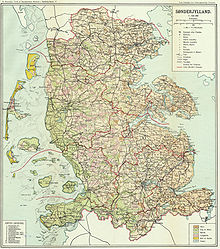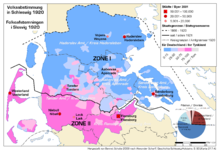Schleswig Plebiscites - Picture
More about World War 1

|
|
Schleswig Plebiscites

Picture - Map of Schleswig / South Jutland before the plebiscites.
The Schleswig Plebiscites were two plebiscites, organized according to section XII, articles 109 to 114 of the Treaty of Versailles of June 28, 1919, in order to determine the future border between Denmark and Germany through the former duchy of Schleswig. The process was monitored by a commission with representatives from France, the United Kingdom, Norway and Sweden.
The Danish-ruled Duchy of Schleswig had been conquered by Prussia and Austria in the 1864 Second War of Schleswig along with the Danish-ruled German provinces of Holstein and Lauenburg. Article 5 of the Austro-Prussian Peace of Prague stipulated that a plebiscite should be held within 6 years to give the people of the northern part of Schleswig the possibility of voting between staying German or separating parts of Schleswig and repartitioning them to Denmark, an arrangement already denied by Denmark after the war of 1848 and again after the war of 1864, and then dropped completely in 1878 in the Treaty of Gastein between Austria and Imperial Germany. The border was respected later by both Denmark and Germany in the Optant Treaty of Copenhagen 1907. After the defeat of Germany in World War I Germany was forced to accept a plebiscite whose unilateral conditions then were defined by Denmark.

Picture - Results of the plebiscite.
The plebiscites were held in two zones that were defined by Denmark. according to the ideas of the Danish historian Hans Victor Clausen Zone I was dimensioned as far towards the South as possible, therefore changing the Clausen-Line southerly from Tondern instead of northerly, and had to vote en bloc, i.e. as a unit with the majority deciding, while in the following smaller Zone II each municipality was to decide its own allegiance, this procedure allowing Denmark to gain further territory and put the frontier further southwards according to eventual majorities in northern municipalities.
The first plebiscite was held in Zone I, the later Northern Schleswig on February 10, 1920. 74.9 % (75,431 votes) of the public voted to come under Danish rule, 25.1 % (25,329 votes) to stay German, although in three of the four major towns and especially in the southern region directly at the frontier to Zone II German majorities existed, especially a large German majority between 70 and 80 percent in and around Tx¸nder and Hx¸jer. It was mostly this area that caused discussions after the voting, especially as this area had been regarded also by Clausen to be south of an imaginary German-Danish border.
Central Schleswig (Zone II) voted on March 14, 1920. 80.2 % (51,742 votes) fell to Germany, 19.8 % (12,800) to Denmark. Since a Danish majority in this zone was only produced in three small villages on the island of Fxĥhr not aligned with the coming border, the Commission Internationale de Surveillance du Plébiscite Slésvig decided on a line almost completely identical to the border between the two zones. The poor result for Denmark in Central Schleswig - particularly in Flensburg, Schleswig's largest city - triggered Denmark's 1920 Easter Crisis.
A plebiscite was not held in the southernmost third of the province (Zone III) as there was no doubt about the outcome.
Selected results in detail:
Zone I (Northern Schleswig):
District Hadersleben / Haderslev: 16.0 % (6,585 votes) Germany, 84.0 % (34,653 votes) Denmark, thereof
Town of Hadersleben / Haderslev: 38.6 % (3,275 votes) Germany, 61.4 % (5,209 votes) Denmark;
District Apenrade / Aabenraa: 32.3 % (6,030 votes) Germany, 67.7 % (12,653 votes) Denmark, thereof
Town Apenrade / Aabenraa: 55.1 % (2,725 votes) Germany, 44.9 % (2,224 votes) Denmark;
District Sonderburg / Sx¸nderborg: 22.9 % (5,083 votes) Germany, 77.1 % (17,100 votes) Denmark, thereof
Town Sonderburg / Sx¸nderborg: 56.2 % (2,601 votes) Germany, 43.8 % (2,029 votes) Denmark and
Spot Augustenburg / Augustenborg: 48.0 % (236 votes) Germany, 52.0 % (votes) Denmark;
District Tondern / Tx¸nder, northern part: 40.9 % (7,083 votes) Germany, 59.1 % (10,223 votes) Denmark, thereof
Town of Tondern / Tx¸nder: 76.5% (2,448 votes) Germany, 23.5 % (750 votes) Denmark,
Spot Hoyer / Hx¸jer: 72.6 % (581 votes) Germany, 27.4 % (219 votes) Denmark and
Spot Lxĵgumkloster / Lx¸gumkloster: 48.8 % (516 votes) Germany, 51.2 % (542 votes) Denmark;
District Flensburg / Flensborg, northern part: 40.6 % (548 votes) Germany, 59.4 % (802 votes) Denmark.
Zone II (Central Schleswig):
District Tondern / Tx¸nder, southern part: 87.9 % (17,283 votes) Germany, 12.1 % (2,376 votes) Denmark;
District Flensburg / Flensborg, southern part: 82.6 % (6,688 votes) Germany, 17.4 % (1,405 votes) Denmark;
District Husum, northern part: 90.0 % (672 votes) Germany, 10.0 % (75 votes) Denmark;
Town of Flensburg / Flensborg: 75.2 % (27,081 votes) Germany, 24.8 % (8,944 votes) Denmark.
Directly after the announcement of the results from Zone I, an alternative draft for the frontier was made by the German historian Johannes Tiedje. The proposed frontier would have incorporated Tondern, Hoyer, Tingleff and neighbouring areas and also some parts northern from Flensburg - the so called Tiedje Belt - and would have created almost equal minorities on both sides of the frontier instead of 30,000 to 35,000 Germans in Denmark and 6,000 to 8,000 Danes in Germany.
This and suggestions like this were not accepted and so Northern Schleswig was surrendered to Denmark on 15 June 1920, and the territory was officially named the South Jutlandic districts, more commonly Southern Jutland, although this name is historically identical to the whole of Schleswig.
Easter Crisis of 1920
Schleswig-Holstein Question
Danish minority in Southern Schleswig
North Schleswig Germans
History of Schleswig-Holstein
Southern Schleswig
Danish constitutional referendum, 1920
Footnotes
More aircraft.
Source: WikiPedia